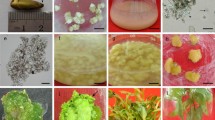Summary
Primary callus of barley (Hordeum vulgare L.) derived from scutella (cv. ‘Dissa’) and anthers (cv. ‘Igri’) was used for protoplast isolation and plant regeneration. The protoplasts were embedded in agarose and cultured with nurse cells. The plating efficiency varied from 0.1% to 0.7%. Shoots regenerated from the developing callus. Plantlets were transferred to soil and cultivated in the greenhouse three to five months after protoplast isolation. All plants were normal in morphology, and most of them flowered and set seeds.
Similar content being viewed by others
Abbreviations
- 2,4-D:
-
2,4-dichlorophenoxyacetic acid
- BAP:
-
6-benylaminopurine
References
Biswas GCG, Burkhardt PK, Wünn J, Klöti A, Potrykus I (1994) Plant Cell Rep 13:528–532
Funatsuki H, Lörz H, Lazzeri PA (1992) Plant Sci 85:179–187
Golds TJ, Babczinky J, Mordhorst AP Koop H-U (1994) Plant Cell Rep 13:188–192
Jähne A, Lazzeri PA, Jäger-Gussen M, Lörz H (1991a) Theor Appl Genet 82:74–80
Jähne A, Lazzeri PA, Lörz H (1991b) Plant Cell Rep 10:1–6
Jain RK, Khera GS, Lee SH, Blackhall NW, Marchant R, Davey MR, Power JB, Cocking EC, Gosal SS (1995) Plant Cell Rep 14:515–519
Karp A, Wu QS, Steele SH, Jones MGK (1987) Theor Appl Genet 74, 140–146
Kihara M, Funatsuki H (1995) Plant Sci 106: 115–120
Kihara M, Funatsuki H (1994) Plant Cell Rep 13: 551–555
Krautwig B, Lörz H (1995) Plant Sci 1ll: 1–10
Lazzeri PA, Brettschneider R, Lührs, Lörz H (1991) Theor Appl Genet 81: 437–444
Lörz H, Göbel E, Brown P (1983) Plant Breeding 100:1–25
Lührs R., Lörz H (1988) Planta 175:71–81
Mordhorst A.P., Lörz H. (1993) J Plant Physiol 142:485–492
Salmenkallio-Martilla M, Kauppinen V (1995) Plant Cell Rep 14:253–256
Shillito RD, Paszkowski J, Potrykus I (1983) Plant Cell Rep 2:244
Thompson JA, Abdullah R, Cocking EC (1986) Plant Sci 47: 123–133
Vasil IK (1992) Physiol Plant 85:279–283
Wang X-H, Lazzeri PA, Lörz H (1992) Theor Appl Genet 85:181–185
Wu C, Zapata FJ, (1992) Plant Sci 86:83–87.
Author information
Authors and Affiliations
Additional information
Communicated by: K. Glimelius
Rights and permissions
About this article
Cite this article
Stöldt, A., Wang, XH. & Lörz, H. Primary callus as source of totipotent barley (Hordeum vulgare L.) protoplasts. Plant Cell Reports 16, 137–141 (1996). https://doi.org/10.1007/BF01890854
Received:
Revised:
Issue Date:
DOI: https://doi.org/10.1007/BF01890854




